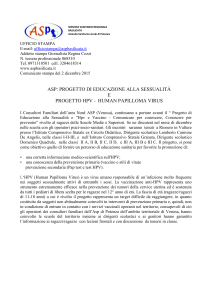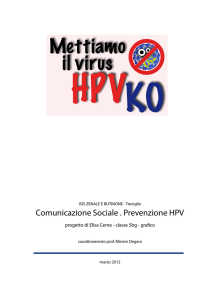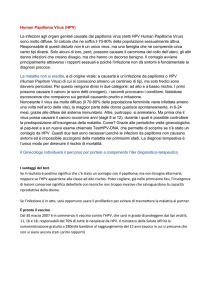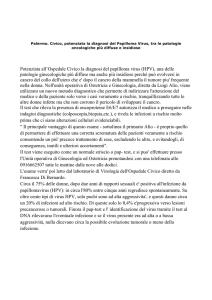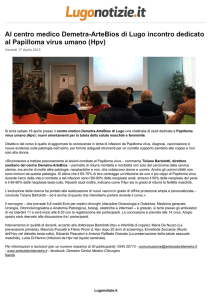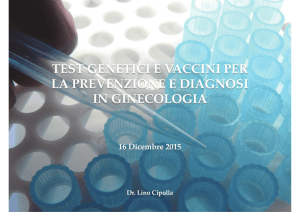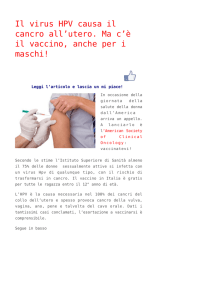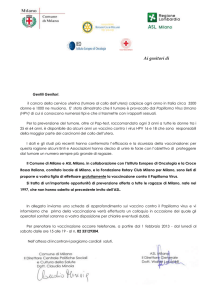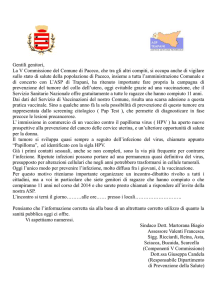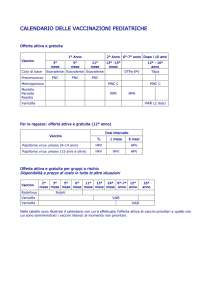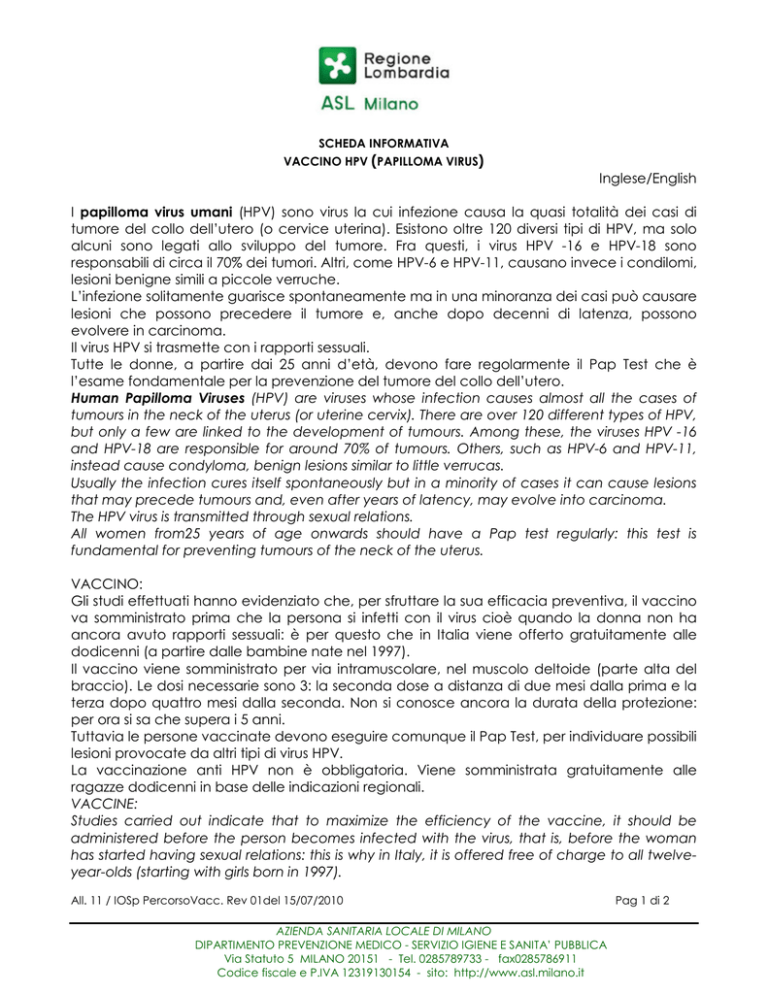
SCHEDA INFORMATIVA
VACCINO HPV (PAPILLOMA VIRUS)
Inglese/English
I papilloma virus umani (HPV) sono virus la cui infezione causa la quasi totalità dei casi di
tumore del collo dell’utero (o cervice uterina). Esistono oltre 120 diversi tipi di HPV, ma solo
alcuni sono legati allo sviluppo del tumore. Fra questi, i virus HPV -16 e HPV-18 sono
responsabili di circa il 70% dei tumori. Altri, come HPV-6 e HPV-11, causano invece i condilomi,
lesioni benigne simili a piccole verruche.
L’infezione solitamente guarisce spontaneamente ma in una minoranza dei casi può causare
lesioni che possono precedere il tumore e, anche dopo decenni di latenza, possono
evolvere in carcinoma.
Il virus HPV si trasmette con i rapporti sessuali.
Tutte le donne, a partire dai 25 anni d’età, devono fare regolarmente il Pap Test che è
l’esame fondamentale per la prevenzione del tumore del collo dell’utero.
Human Papilloma Viruses (HPV) are viruses whose infection causes almost all the cases of
tumours in the neck of the uterus (or uterine cervix). There are over 120 different types of HPV,
but only a few are linked to the development of tumours. Among these, the viruses HPV -16
and HPV-18 are responsible for around 70% of tumours. Others, such as HPV-6 and HPV-11,
instead cause condyloma, benign lesions similar to little verrucas.
Usually the infection cures itself spontaneously but in a minority of cases it can cause lesions
that may precede tumours and, even after years of latency, may evolve into carcinoma.
The HPV virus is transmitted through sexual relations.
All women from25 years of age onwards should have a Pap test regularly: this test is
fundamental for preventing tumours of the neck of the uterus.
VACCINO:
Gli studi effettuati hanno evidenziato che, per sfruttare la sua efficacia preventiva, il vaccino
va somministrato prima che la persona si infetti con il virus cioè quando la donna non ha
ancora avuto rapporti sessuali: è per questo che in Italia viene offerto gratuitamente alle
dodicenni (a partire dalle bambine nate nel 1997).
Il vaccino viene somministrato per via intramuscolare, nel muscolo deltoide (parte alta del
braccio). Le dosi necessarie sono 3: la seconda dose a distanza di due mesi dalla prima e la
terza dopo quattro mesi dalla seconda. Non si conosce ancora la durata della protezione:
per ora si sa che supera i 5 anni.
Tuttavia le persone vaccinate devono eseguire comunque il Pap Test, per individuare possibili
lesioni provocate da altri tipi di virus HPV.
La vaccinazione anti HPV non è obbligatoria. Viene somministrata gratuitamente alle
ragazze dodicenni in base delle indicazioni regionali.
VACCINE:
Studies carried out indicate that to maximize the efficiency of the vaccine, it should be
administered before the person becomes infected with the virus, that is, before the woman
has started having sexual relations: this is why in Italy, it is offered free of charge to all twelveyear-olds (starting with girls born in 1997).
All. 11 / IOSp PercorsoVacc. Rev 01del 15/07/2010
AZIENDA SANITARIA LOCALE DI MILANO
DIPARTIMENTO PREVENZIONE MEDICO - SERVIZIO IGIENE E SANITA’ PUBBLICA
Via Statuto 5 MILANO 20151 - Tel. 0285789733 - fax0285786911
Codice fiscale e P.IVA 12319130154 - sito: http://www.asl.milano.it
Pag 1 di 2
The vaccine is administered through intramuscular injection in the deltoid muscle (upper
arm). Three doses are necessary: the second dose two months after the first and the third at
four months after the second. The duration of protection is still not yet known: at present it is
known to last at least five years.
In any case, those who have had the vaccine should still undergo the Pap test, id order to
identify any eventual lesions caused by other types of HPV virus.
The anti-HPV vaccination is not obligatory. It is offered free of charge to twelve-year-old girls
based on regional policy.
CONTROINDICAZIONI:
• reazione allergica grave (anafilassi) ad una precedente dose di vaccino o ad un suo
componente
E’ opportuno rimandare la vaccinazione in presenza di malattie acute febbrili o disturbi
generali giudicati importanti dal medico.
CONTRAINDICATIONS:
• serious allergic reaction (anaphylaxis) after administration to a preceding vaccine dose
or to one of its components
It is important to postpone the vaccination if there is evidence of acute febrile illnesses or
other general problems judged to be serious by the doctor.
EFFETTI COLLATERALI:
Sono possibili reazioni nelle sede dell’iniezione: arrossamento, dolore, gonfiore e generali: mal
di testa, dolore muscolare, senso di stanchezza, eventualmente febbre.
Nella maggioranza dei casi questi effetti collaterali sono di lieve entità e durata.
Tuttavia, come per tutti i vaccini, non è possibile escludere l’eventualità di reazioni allergiche
anche gravi come lo shock anafilattico.
SIDE EFFECTS
Reactions around the point of injection are possible: reddening, pain, swelling and more
generally, headaches, muscular pains, sense of fatigue, and possible temperatures.
In the majority of cases, these side effects are light and do now last long.
However, as with all vaccines, it is not possible to exclude the possibility of even serious
allergic reactions such as anaphylactic shock.
All. 11 / IOSp PercorsoVacc. Rev 01del 15/07/2010
AZIENDA SANITARIA LOCALE DI MILANO
DIPARTIMENTO PREVENZIONE MEDICO - SERVIZIO IGIENE E SANITA’ PUBBLICA
Via Statuto 5 MILANO 20151 - Tel. 0285789733 - fax0285786911
Codice fiscale e P.IVA 12319130154 - sito: http://www.asl.milano.it
Pag 2 di 2


